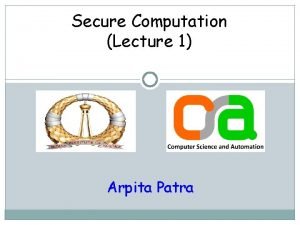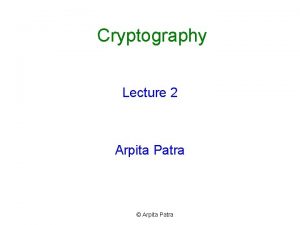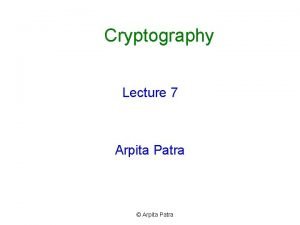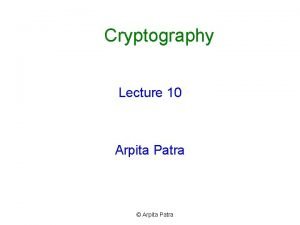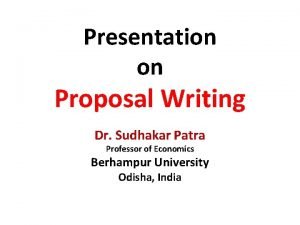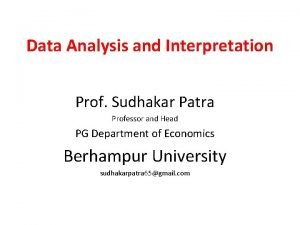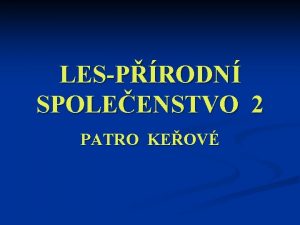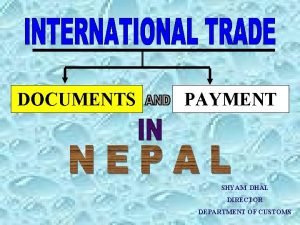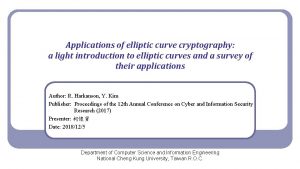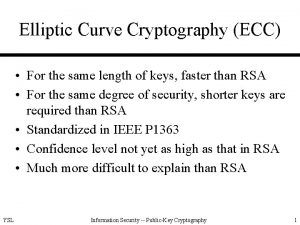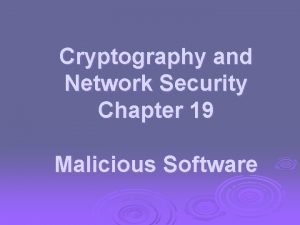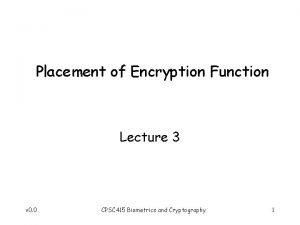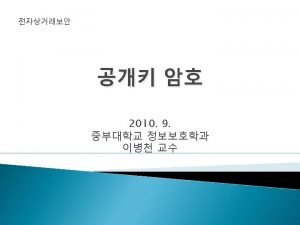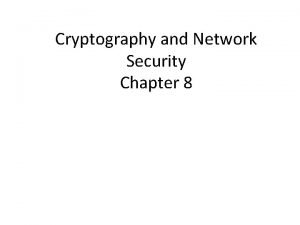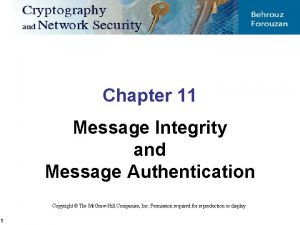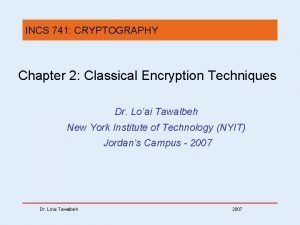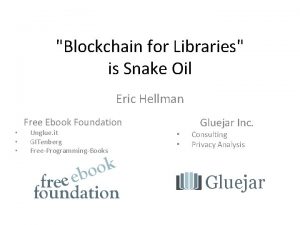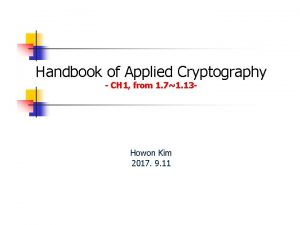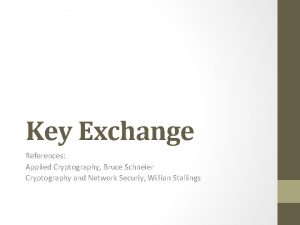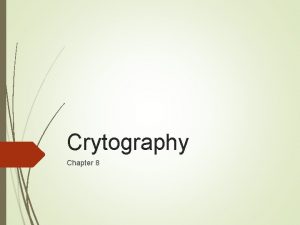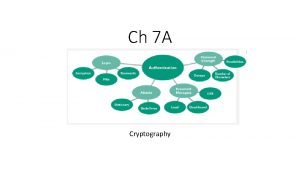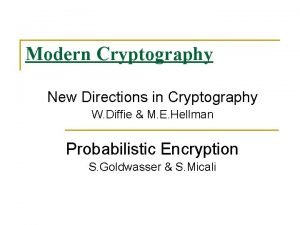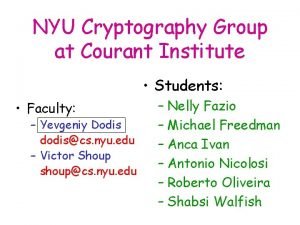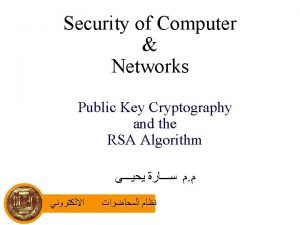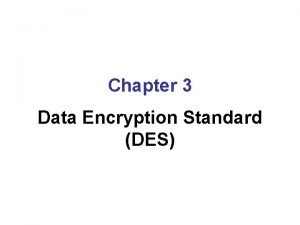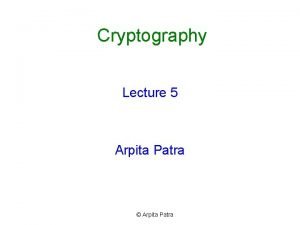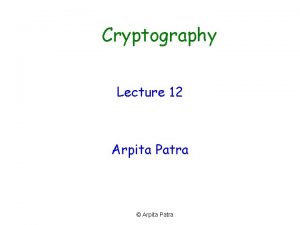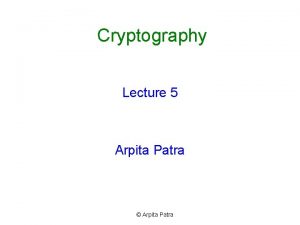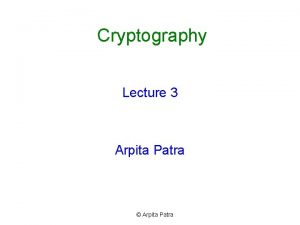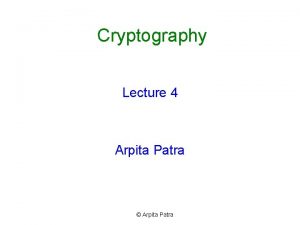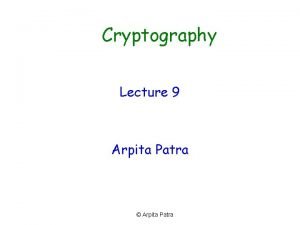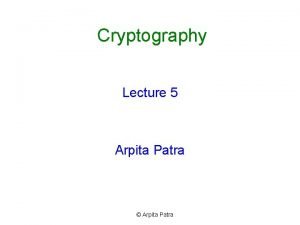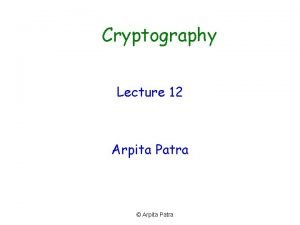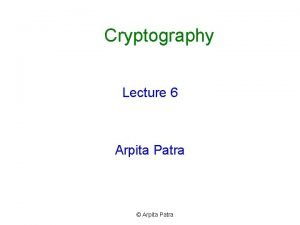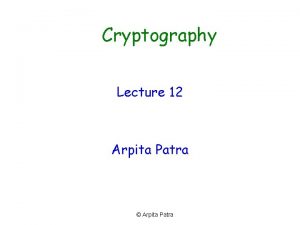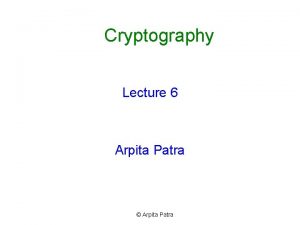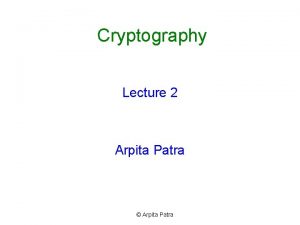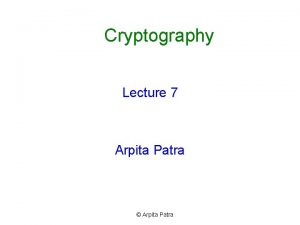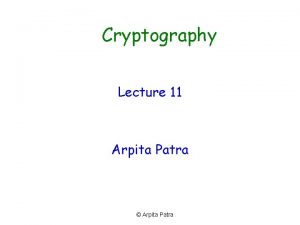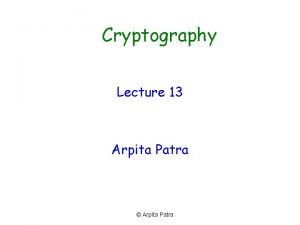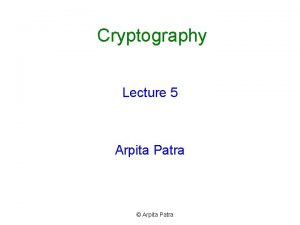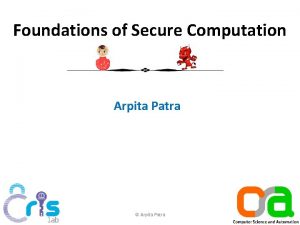Cryptography Lecture 11 Arpita Patra Generic Results in





































- Slides: 37

Cryptography Lecture 11 Arpita Patra

Generic Results in PK World CPA Security Bit Encryption CCA Security Many-bit Encryption CPA-secure KEM SKE Gen. Hyb m k Enc. SKE = (Gen, Hyb CCA-secure SKE Gen Dec. Hyb Encaps = Many-Bit Encryption CCA-secure KEM Hyb CPA-secure SKE COA-secure SKE pk Bit Encryption sk c (c, c. SKE) c. SKE c Decaps k c. SKE Dec. SKE m SKE = (Gen. SKE, Enc. SKE, Dec. SKE) Encaps, Decaps) Hyb = (Gen. Hyb, Enc. Hyb, Dec. Hyb)

Constructions for PK World CPA Security CCA Security PKE Instantiation: DDH based El Gamal Instantiation: DDH + CR Hash based Cramer. Shoup Scheme (first ever CCA secure under standard assumption ) KEM Instantiation: HDH based variation of El Gamal KEM Instantiation: ODH based (the same) variation of El Gamal Variant El Gamal KEM Hyb PRG-based SKE CPA-secure Gen. Hyb m Encaps k Enc. SKE = (Gen, CPA-secure SKE + s. CMA MAC = Gen Dec. Hyb Enc. Hyb pk Variant El. Gamal KEM sk c (c, c. SKE) c. SKE c Decaps k c. SKE Dec. SKE m SKE = (Gen. SKE, Enc. SKE, Dec. SKE) Encaps, Decaps) Hyb = (Gen. Hyb, Enc. Hyb, Dec. Hyb) Hyb CCA-secure

CCA Security for KEM CCA experiment KEM cca A, (n) = (Gen, Encaps, Decaps) Also have to give Decapssk (. ) service to the(c, k) attacker Encapspk(1 n) k’ k if b=0 pk PPT A uniform random string, b =1 (c, k’) b {0, 1} b’ {0, 1} I can break Let me verify pk, sk Gen(1 n) (Attacker’s guess about encapsulated key) ’ b=b Game Output b b ’ 1 --- attacker won 0 --- attacker lost is CPA-secure if for every PPT attacker A, the probability that A wins the experiment is at most negligibly better than ½ cca Pr KEM (n) A, =1 ½ + negl(n)

El Gamal like KEM Gen(1 n) (G, o, q, g) h = gx. For random x pk= (G, o, q, g, h), sk = x pk= (G, o, q, g, h, H), sk = x Encpk(m) Encapspk(1 n) c 2 = hy. . m - Need to choose m randomly - Multiplication c= (c 1, c 2) - Ciphertext= 2 elements c 1 = gy for random y Decsk(c) c 2 / (c 1)x = c 2. [(c 1)x]-1 - Multiplication Security: DDH Assumption - No need of that - No Multiplication, hashing - Ciphertext= 1 element - No Multiplication, hashing Security: ? ? c = gy for random y k = H(hy) = H(gxy. ) (c, k) Decapssk(c) k = H(cx )= H(gxy )

El Gamal like KEM Gen(1 n) (G, o, q, g) h = gx. For random x pk= (G, o, q, g, h, H), sk = x Encapspk(1 n) c = gy for random y k= H(hy) = H(gxy. ) Decsk(c) k = H(cx )= H(gxy ) (c, k) ODH (Oracle Diffie-Hellman) Assumption ODH problem is hard relative to (G, o) and hash function H: G -> {0, 1} m if for every PPT A, (it is hard to distinguish H(gxy) from a random string {0, 1}m even given gx, gy AND an oracle Oy(X): = H(Xy); anything other than gx can be quired) ): | Pr[Ao y(. ) (G, o, q, g, gx, gy, H(gxy )) = 1] - Pr[Aoy(. ) (G, o, q, g, gx, gy, r ) = 1] | negl() ODH assumption is just the belief that there exist a group and hash function H so that the above is true. It is stronger than HDH. Theorem: ODH assumption holds is a CCA-secure KEM

Construction of Hybrid CCA-secure PKE Gen. Hyb Encaps k m Enc. SKE = (Gen, Gen Dec. Hyb Enc. Hyb pk = sk c (c, c. SKE) c. SKE c Decaps k c. SKE Dec. SKE m Encaps, Decaps) SKE = (Gen. SKE, Enc. SKE, Dec. SKE) Hyb = (Gen. Hyb, Enc. Hyb, Dec. Hyb) CCA Secure SKE - CPA Secure SKE + Strong CMA Secure MAC CCA Secure Oracle Function assumption (ODH) - DHIES (Diffie-Hellman Integrated Encryption Scheme)- – ISO/IEC 18033 -2

DHIES- – ISO/IEC 18033 -2 (CCA) = (Gen, Encaps, Decaps) Gen. Hyb = (G, o, q, g) SKE (CPA) = (Gen. SKE, Enc. SKE, Dec. SKE) h = gx. For random x MAC (s. CMA)= (Gen. MAC, Mac, Vrfy) H: G {0, 1}2 n Hyb (CCA) = (Gen. Hyb, Enc. Hyb, Dec. Hyb) pk= (G, o, q, g, h, H), sk = x Enc. Hyb pk c = gy for random y k= sk c (c, c. SKE=(c. CPA, t. MAC)) H(hy) = H(gxy. ) Dec. Hyb k = H(cx ) c = H(gxy ) k k k=k. E || k. M m k. E Enc. CPA Macs. CMA c. CPA k=k. E || k. M t. MAC c. SKE k. M (c. CPA, t. MAC) k. E Vrfys. CMA Yes CCA Secure SKE - CPA Secure SKE + Strong CMA Secure MAC CCA Secure Number theoretic assumption + Hash Function (ODH) - c. CPA Dec. CPA m m

DHIES (Term Paper) Michel Abdalla, Mihir Bellare, Phillip Rogaway: The Oracle Diffie-Hellman Assumptions and an Analysis of DHIES. CT-RSA 2001: 143 -158

Cramer-Shoup Cryptosystem Ronald Cramer, Victor Shoup: A Practical Public Key Cryptosystem Provably Secure Against Adaptive Chosen Ciphertext Attack. CRYPTO 1998: 13 -25

Cramer-Shoup Cryptosystem- Route map Another Look at DDH Assumption/ An alternative Formulation CPA Secure Scheme (different from El Gamal) CCA 1 Secure Scheme + Collision-Resistant Hash Function CCA Secure Scheme

Another Look at DDH (G, o, q, g) – Group of Prime Order q | Pr[A(g, gx, gy, gxy ) = 1] - (g 0, g 1, g 0 y, g 1 y ) | Pr[A(g , g 1, g r ) = 1] 0 0 1 Pr[A(g, gx, gy, gz ) = 1] | negl() (g 0, g 1, g 0 y, g 1 y’ ) - Pr[A(g 0, g 1, g 0 r, g 1 r’ ) = 1] | negl()

Randomization Function Input Output (g 0, g 1, h 0, h 1 ) Random (x, y) from Zq u = g 0 x. g 1 y Way 1: Given x, y, h 0 , h 1 v = h 0 x. h 1 y Way 2: Given r, u Case I (g 0, g 1, h 0 = g 0 r , h 1 = g 1 r): Claim: ur = v Proof: ur = (g 0 x. g 1 y)r = h 0 x. h 1 y = v Case II (g 0, g 1, h 0 = g 0 r , h 1 = g 1 r’ ): Claim: An all powerful adv A can guess v with probability at most 1/|G|, even given (g 0, g 1, h 0, h 1, u). Proof: A can compute r, r’, α (where g 1 = g 0α) and discrete log of u (say R) u = g 0 R = (g 0 x. g 1 y) = g 0 x +αy = R --- (1) v = h 0 x. h 1 y = g 0 rx. g 1 r’y = g 0 rx +αr’y is linearly independent of x +αy For every guess R’ of this value rx +αr’y, there exist a pair of unique values for x, y satisfying equation (1)

CPA Secure Scheme Gen(1 n) Decsk = (x, y)(h 0, h 1 , c) Encpk(m) (G, o, q, g 0, g 1) v = h 0 x. h 1 y (Way 1) Random r from Zq Random (x, y) from Zq m = c/v h 0 = g 0 r , h 1 = g 1 r u = g 0 x. g 1 y c = ur. m = v. m (Way 2) pk= (G, o, q, g 0, g 1, u), sk = (x, y) (h 0, h 1 , c) Theorem. If DDH is hard, then is a CPA-secure scheme. Proof: Assume is not CPA-secure A, p(n): cpa Pr Pub. K (n) = 1 A, DDH or non-DDH tuple? (G, o, q, g 0, g 1, h 0, h 1) > ½ + 1/p(n) D Random (x, y) from Zq u = g 0 x. g 1 y c = h 0 x. h 1 y. mb cpa Let us run Pub. K (n) A, pk = (G, o, q, g 0, g 1, u) m 0, m 1 , |m 0| = |m 1| (h 0, h 1 , c) b’ {0, 1} A

CPA Secure Scheme Gen(1 n) Decsk = (x, y)(h 0, h 1 , c) Encpk(m) (G, o, q, g 0, g 1) v = h 0 x. h 1 y (Way 1) Random r from Zq Random (x, y) from Zq m = c/v h 0 = g 0 r , h 1 = g 1 r u = g 0 x. g 1 y c = ur. m = v. m (Way 2) pk= (G, o, q, g 0, g 1, u), sk = (x, y) (h 0, h 1 , c) Theorem. If DDH is hard, then is a CPA-secure scheme. Proof: Assume is not CPA-secure A, p(n): cpa Pr Pub. K (n) = 1 A, ½ + 1/p(n) > cpa Let us run Pub. K (n) A, D DDH Tuple (G, o, q, g 0, g 1, h 0 = g 0 r, h 1 = g 1 r) Random (x, y) from Zq u = g 0 x. g 1 y h 0 x. h 1 y = g 0 rx. g 1 ry = c = h 0 x. h 1 y. mb ur pk = (G, o, q, g 0, g 1, u) m 0, m 1 , |m 0| = |m 1| (h 0, h 1 , c) b’ {0, 1} A

CPA Secure Scheme Gen(1 n) Decsk = (x, y)(h 0, h 1 , c) Encpk(m) (G, o, q, g 0, g 1) v = h 0 x. h 1 y (Way 1) Random r from Zq Random (x, y) from Zq m = c/v h 0 = g 0 r , h 1 = g 1 r u = g 0 x. g 1 y c = ur. m = v. m (Way 2) pk= (G, o, q, g 0, g 1, u), sk = (x, y) (h 0, h 1 , c) Theorem. If DDH is hard, then is a CPA-secure scheme. Proof: Assume is not CPA-secure A, p(n): cpa Pr Pub. K (n) = 1 A, Non-DDH Tuple > ½ + 1/p(n) D (G, o, q, g 0, g 1, h 0 = g 0 r, h 1 = g 1 r’) Random (x, y) from Zq u = g 0 x. g 1 y h 0 x. h 1 y is uniformly random element c = h 0 x. h 1 y. mb cpa Pr Pub. K (n) = 1 A, = ½ cpa Let us run Pub. K (n) A, pk = (G, o, q, g 0, g 1, u) m 0, m 1 , |m 0| = |m 1| (h 0, h 1 , c) b’ {0, 1} A

CPA Secure Scheme Gen(1 n) Decsk = (x, y)(h 0, h 1 , c) Encpk(m) (G, o, q, g 0, g 1) v = h 0 x. h 1 y (Way 1) Random r from Zq Random (x, y) from Zq m = c/v h 0 = g 0 r , h 1 = g 1 r u = g 0 x. g 1 y c = ur. m = v. m (Way 2) pk= (G, o, q, g 0, g 1, u), sk = (x, y) (h 0, h 1 , c) Theorem. If DDH is hard, then is a CPA-secure scheme. Proof: Assume is not CPA-secure A, p(n): cpa Pr Pub. K (n) = 1 A, > ½ + 1/p(n) = Pr [D(DDH tuple) = 1] DDH or non-DDH tuple? (G, o, q, g 0, g 1, h 0, h 1) 1 if b = b’ 0 otherwise - D Random (x, y) from Zq u = g 0 x. g 1 y c = h 0 x. h 1 y. mb cpa Pr Pub. K (n) = 1 A, = Pr [D(non-DDH tuple) = 1] ½ = > 1/p(n) cpa Let us run Pub. K (n) A, pk = (G, o, q, g 0, g 1, u) m 0, m 1 , |m 0| = |m 1| (h 0, h 1 , c) b’ {0, 1} A

Why NOT El Gamal? Gen(1 n) Encpk(m) (G, o, q, g) Random x from Zq, c 1 = h = gx gy Decsk(c) for random y c 2 / (c 1)x = c 2. [(c 1)x]-1 c 2 = gxy. . m pk= (G, o, q, g 0, h), sk = x Theorem. If DDH is hard, then is a CPA-secure scheme. Proof: Assume is not CPA-secure A, p(n): cpa Pr Pub. K (n) = 1 A, > = cpa Pr Pub. K (n) = 1 A, ½ + 1/p(n) Pr [D(DDH tuple) = 1] - = Pr [D(non-DDH tuple) = 1] The secret key is not with the reduction and so cannot Let us run DDH or non-DDH tuple? provide DO service to A! (G, o, q, g, g x, g y, gz) D 0 otherwise , |m 0| = |m 1| c = (gy, gz. mb) 1 if b = b’ b ½ > 1/p(n) cpa Pub. K (n) A, pk = (G, o, q, g, gx) m 0, m 1 = b’ {0, 1} A

Is the Scheme CCA secure? Gen(1 n) Encpk(m) (G, o, q, g 0, g 1) Random r from Zq Random (x, y) from Zq h 0 = g 0 r , h 1 = g 1 r u = g 0 x. g 1 y pk= (G, o, q, g 0, g 1, u), sk = (x, y) c = ur. m = v. m (Way 2) (h 0, h 1 , c) It is malleable. Not CCA Secure Decsk = (x, y)(h 0, h 1 , c) v = h 0 x. h 1 y (Way 1) m = c/v

Is the Scheme CCA 1 secure? Gen(1 n) Decsk = (x, y)(h 0, h 1 , c) Encpk(m) (G, o, q, g 0, g 1) v = h 0 x. h 1 y (Way 1) Random r from Zq Random (x, y) from Zq m = c/v h 0 = g 0 r , h 1 = g 1 r u = g 0 x. g 1 y c = ur. m = v. m (Way 2) pk= (G, o, q, g 0, g 1, u), sk = (x, y) (h 0, h 1 , c) Theorem. If DDH is hard, then is a CPA-secure scheme. Proof: Assume is not CPA-secure A, p(n): cpa Pr Pub. K (n) = 1 A, > ½ + 1/p(n) = Pr [D(DDH tuple) = 1] DDH or non-DDH tuple? (G, o, q, g 0, g 1, h 0, h 1) 1 if b = b’ 0 otherwise - D Random (x, y) from Zq u = g 0 x. g 1 y c = h 0 x. h 1 y. mb cpa Pr Pub. K (n) = 1 Au, ½ = = Pr [D(non-DDH tuple) = 1] > 1/p(n) pk = (G, o, q, g 0, g 1, u) Decryption query m 0, m 1 , |m 0| = |m 1| (h 0, h 1 , c) b’ {0, 1} A

Is the Scheme CCA 1 secure? Gen(1 n) (G, o, q, g 0, g 1) Random (x, y) from Zq u = g 0 x. g 1 y pk= (G, o, q, g 0, g 1, u), sk = (x, y) Encpk(m) Random r from Zq h 0 = g 0 r , h 1 = g 1 r Decsk = (x, y)(h 0, h 1 , c) v = h 0 x. h 1 y (Way 1) m = c/v c = ur. m = v. m (Way 2) (h 0, h 1 , c) Claim. Just one decryption query is enough for an unbounded powerful adversary A u to know x, y and guess b with probability 1. Proof: Au can compute discrete log of u & g 1, say R & α u = g 0 R = (g 0 x. g 1 y) = g 0 x +αy = R --- (1) Au need another (linearly) independent equation on x and y to recover them. Can Decryption Query help? D Random (x, y) from Zq u = g 0 x. g 1 y pk = (G, o, q, g 0, g 1, u) DQ: (h 0, h 1 , c) Au

Is the Scheme CCA 1 secure? Gen(1 n) Decsk = (x, y)(h 0, h 1 , c) Encpk(m) (G, o, q, g 0, g 1) v = h 0 x. h 1 y (Way 1) Random r from Zq Random (x, y) from Zq m = c/v h 0 = g 0 r , h 1 = g 1 r u = g 0 x. g 1 y c = ur. m = v. m (Way 2) pk= (G, o, q, g 0, g 1, u), sk = (x, y) (h 0, h 1 , c) Claim. Just one decryption query is enough for an unbounded powerful adversary to know x, y and guess b with probability 1. Proof: Au can compute discrete log of u & g 1, say R & α u = g 0 R = (g 0 x. g 1 y) = g 0 x +αy = R --- (1) Au need another (linearly) independent equation on x and y to recover them. Can Decryption Query help? c/m = v = g 0 R’ = (h 0 x. h 1 y) = g 0 rx +rαy = R’ --- (2) D Random (x, y) from Zq u= g 0 x. g 1 y (linearly) Dependent No use pk = (G, o, q, g 0, g 1, u) DQ: (h 0 = g 0 r, h 1 = g 1 r , c) m Au

Is the Scheme CCA 1 secure? Gen(1 n) Decsk = (x, y)(h 0, h 1 , c) Encpk(m) (G, o, q, g 0, g 1) v = h 0 x. h 1 y (Way 1) Random r from Zq Random (x, y) from Zq m = c/v h 0 = g 0 r , h 1 = g 1 r u = g 0 x. g 1 y c = ur. m = v. m (Way 2) pk= (G, o, q, g 0, g 1, u), sk = (x, y) (h 0, h 1 , c) Claim. Just one decryption query is enough for an unbounded powerful adversary to know x, y and guess b with probability 1. Proof: Au can compute discrete log of u & g 1, say R & α x +αy = R --- (1) u = g 0 R = (g 0 x. g 1 y) = g 0 x +αy Au need another (linearly) independent equation on x and y to recover them. Can Decryption Query help? c/m = v = g 0 R’ = (h 0 x. h 1 y) = g 0 rx +r’αy = R’ --- (2) (linearly) independent Solving (1) & (2) gives the secret key (x, y) cpa Pr Pub. K (n) = 1 Au, =1 D Random (x, y) from Zq u= g 0 x. g 1 y pk = (G, o, q, g 0, g 1, u) DQ: (h 0 = g 0 r, h 1 = g 1 r’ , c) m Au

CPA Secure Scheme Gen(1 n) Decsk = (x, y)(h 0, h 1 , c) Encpk(m) (G, o, q, g 0, g 1) v = h 0 x. h 1 y (Way 1) Random r from Zq Random (x, y) from Zq m = c/v h 0 = g 0 r , h 1 = g 1 r u = g 0 x. g 1 y c = ur. m = v. m (Way 2) pk= (G, o, q, g 0, g 1, u), sk = (x, y) (h 0, h 1 , c) Theorem. If DDH is hard, then is a CPA-secure scheme. Proof: Assume is not CPA-secure A, p(n): cpa Pr Pub. K (n) = 1 A, = > ½ + 1/p(n) = Illegal Decryption Query: (g 0 r, g 1 r’ , c) Pr [D(DDH tuple) = 1] DDH or non-DDH tuple? (G, o, q, g 0, g 1, h 0, h 1) 1 if b = b’ 0 otherwise cpa Pr Pub. K (n) = 1 A, - Pr [D(non-DDH tuple) = 1] ½ = > 1/p(n) cpa illegal queries A checking mechanism in Dec so that Let us run Pub. K (n) will be REJECTED with very high. A, probability D Random (x, y) from Zq u = g 0 x. g 1 y c = h 0 x. h 1 y. mb pk = (G, o, q, g 0, g 1, u) m 0, m 1 , |m 0| = |m 1| (h 0, h 1 , c) b’ {0, 1} A

CCA 1 Scheme Gen(1 n) Encpk(m) Decsk = (x, y, x’, y’)(h 0, h 1 , c, f) (G, o, q, g 0, g 1) Random r from Zq f = h 0 x’ h 1 y’ (Way 1) ? ? Random (x, y, x’, y’) from Zq h 0 = g 0 r , h 1 = g 1 r v = h 0 x h 1 y (Way 1) u = g 0 x g 1 y e = g 0 x’ g 1 y’ c = ur. m = v. m ; f = er (Way 2) m = c/v pk= (G, o, q, g 0, g 1, u, e), sk = (x, y, x’, y’) (h 0, h 1 , c, f) Claim. An unbounded powerful adversary computes (x, y) except with neg. probability. Therefore it can guess bit b with probability no better than ½ + negl(. ). Proof: Au can compute discrete log of u, e g 1, say R, S & α u = g 0 R = (g 0 x g 1 y) = g 0 x +αy = R -(1) e = g 0 S = (g 0 x’ g 1 y’) = g 0 x’ +αy’ = S -(2) What if Au can guess f so that f = h 0 x’ h 1 y’ ? ? Do you see the disaster? ? ? ? f = g 0 S’ = (h 0 x’ h 1 y’) = g 0 rx +r’αy rx’ +r’αy’ = S’ --- (3) (linearly) independent of (2) c/m = v = g 0 R’ = (h 0 x. h 1 y) = g 0 rx +r’αy = R’ --- (4) (linearly) independent of (1) Solving (1) & (4) gives the secret key (x, y) cpa Pr Pub. K (n) = 1 Au, =1 D Random (x, y, x’, y’) from Zq u= g 0 x g 1 y e= g 0 x’ g 1 y’ f = h 0 x’ h 1 y’ ? ? If yes, then send m pk = (G, o, q, g 0, g 1, u, e) DQ: (h 0=g 0 r, h 1=g 1 r’ , c, f) m Au

Security Proof of CCA 1 Scheme Gen(1 n) Encpk(m) Decsk = (x, y, x’, y’)(h 0, h 1 , c, f) (G, o, q, g 0, g 1) Random r from Zq f = h 0 x’ h 1 y’ (Way 1) ? ? Random (x, y, x’, y’) from Zq h 0 = g 0 r , h 1 = g 1 r v = h 0 x h 1 y (Way 1) u = g 0 x g 1 y e = g 0 x’ g 1 y’ c = ur. m = v. m ; f = er (Way 2) m = c/v pk= (G, o, q, g 0, g 1, u, e), sk = (x, y, x’, y’) (h 0, h 1 , c, f) Claim. An unbounded powerful adversary computes (x, y) except with neg. probability. Therefore it can guess bit b with probability no better than ½ + negl(. ). Proof: Au can compute discrete log of u & g 1, say R & α x +αy = R --- (1) u = g 0 R = (g 0 x g 1 y) = g 0 x +αy e = g 0 S = (g 0 x’ g 1 y’) = g 0 x’ +αy’ What is the prob of Au guessing f Yes! It does. Au knows its chosen value in the first x’ +αy’is= NOT S --- (2) DQ a possibility. Next time it can guess f from G minus that value so that f = h x’ h y’ = g rx +αr’y in his FIRST DQ 0 1 0 Recall that h 0 x’ h 1 y’ is uniformly random for Au even given (g 0, g 1, h 0=g 0 r, h 1=g 1 r’ , e) Pr[Au succeeds in first DQ] = 1/|G| --- negligible But Au can make polynomials many attempts say, t many. Does getting rejected in the first DQ help in succeeding second DQ? D Random (x, y, x’, y’) from Zq u= g 0 x g 1 y e= g 0 x’ g 1 y’ f = h 0 x’ h 1 y’ ? ? If yes, then send m pk = (G, o, q, g 0, g 1, u, e) DQ: (h 0=g 0 r, h 1=g 1 r’ , c, f) m Au

Security Proof of CCA 1 Scheme Gen(1 n) Encpk(m) Decsk = (x, y, x’, y’)(h 0, h 1 , c, f) (G, o, q, g 0, g 1) Random r from Zq f = h 0 x’ h 1 y’ (Way 1) ? ? Random (x, y, x’, y’) from Zq h 0 = g 0 r , h 1 = g 1 r v = h 0 x h 1 y (Way 1) u = g 0 x g 1 y e = g 0 x’ g 1 y’ c = ur. m = v. m ; f = er (Way 2) m = c/v pk= (G, o, q, g 0, g 1, u, e), sk = (x, y, x’, y’) (h 0, h 1 , c, f) Claim. An unbounded powerful adversary computes (x, y) except with neg. probability. Therefore it can guess bit b with probability no better than ½ + negl(. ). Proof: Au can compute discrete log of u & g 1, say R & α u = g 0 R = (g 0 x g 1 y) = g 0 x +αy = R --- (1) e = g 0 S = (g 0 x’ g 1 y’) = g 0 x’ +αy’ = S --- (2) What is the prob of Au guessing f so that f = h 0 x’ h 1 y’ = g 0 rx +αr’y in his SECOND DQ Pr[Au succeeds in second DQ] = 1 / (|G|-1) - negligible D Random (x, y, x’, y’) from Zq u= g 0 x g 1 y e= g 0 x’ g 1 y’ f = h 0 x’ h 1 y’ ? ? If yes, then send m pk = (G, o, q, g 0, g 1, u, e) DQ: (h 0=g 0 r, h 1=g 1 r’ , c, f) m Au

Security Proof of CCA 1 Scheme Gen(1 n) Encpk(m) Decsk = (x, y, x’, y’)(h 0, h 1 , c, f) (G, o, q, g 0, g 1) Random r from Zq f = h 0 x’ h 1 y’ (Way 1) ? ? Random (x, y, x’, y’) from Zq h 0 = g 0 r , h 1 = g 1 r v = h 0 x h 1 y (Way 1) u = g 0 x g 1 y e = g 0 x’ g 1 y’ c = ur. m = v. m ; f = er (Way 2) m = c/v pk= (G, o, q, g 0, g 1, u, e), sk = (x, y, x’, y’) (h 0, h 1 , c, f) Claim. An unbounded powerful adversary computes (x, y) except with neg. probability. Therefore it can guess bit b with probability no better than ½ + negl(. ). Proof: Au can compute discrete log of u & g 1, say R & α u = g 0 R = (g 0 x g 1 y) = g 0 x +αy = R --- (1) e = g 0 S = (g 0 x’ g 1 y’) = g 0 x’ +αy’ = S --- (2) What is the prob of Au guessing f so that f = h 0 x’ h 1 y’ = g 0 rx +αr’y in his tth DQ (t is the upper bound on the number of DQs) Pr[Au succeeds in tth DQ] = 1 / (|G|-t) - negligible Pr[Au succeeds in one of t DQs] ≤ t / (|G|-t) - negligible Pr cpa Pub. K (n) Au, =1 ≤ ½ + negl(. ) D Random (x, y, x’, y’) from Zq u= g 0 x g 1 y e= g 0 x’ g 1 y’ f = h 0 x’ h 1 y’ ? ? If yes, then send m pk = (G, o, q, g 0, g 1, u, e) DQ: (h 0=g 0 r, h 1=g 1 r’ , c, f) m Au

Is the Scheme CCA-secure? Gen(1 n) Encpk(m) Decsk = (x, y, x’, y’)(h 0, h 1 , c, f) (G, o, q, g 0, g 1) Random r from Zq f = h 0 x’ h 1 y’ (Way 1) ? ? Random (x, y, x’, y’) from Zq h 0 = g 0 r , h 1 = g 1 r v = h 0 x h 1 y (Way 1) u = g 0 x g 1 y e = g 0 x’ g 1 y’ c = ur. m = v. m ; f = er (Way 2) m = c/v pk= (G, o, q, g 0, g 1, u, e), sk = (x, y, x’, y’) (h 0, h 1 , c, f) Claim. Just one DQ in post-challenge phase is enough for an unbounded powerful adversary to compute (x, y) completely and guess bit b with probability 1. Proof: Au can compute discrete log of u & g 1, say R & α u = g 0 R = (g 0 x g 1 y) = g 0 x +αy = R --- (1) e = g 0 S = (g 0 x’ g 1 y’) = g 0 x’ +αy’ = S --- (2) What is the prob of Au guessing f so that f = h 0 x’ h 1 y’ = g 0 rx +αr’y in his tth DQ (t is the upper bound on the number of DQs) Pr[Au succeeds in tth DQ] = 1 / (|G|-t) - negligible Pr[Au succeeds in one of t DQs] ≤ t / (|G|-t) - negligible Pr cpa Pub. K (n) Au, =1 ≤ ½ + negl(. ) D Random (x, y, x’, y’) from Zq u= g 0 x g 1 y e= g 0 x’ g 1 y’ f = h 0 x’ h 1 y’ ? ? If yes, then send m pk = (G, o, q, g 0, g 1, u, e) DQ: (h 0=g 0 r, h 1=g 1 r’ , c, f) m Au

Is the Scheme CCA-secure? Gen(1 n) Encpk(m) Decsk = (x, y, x’, y’)(h 0, h 1 , c, f) (G, o, q, g 0, g 1) Random r from Zq f = h 0 x’ h 1 y’ (Way 1) ? ? Random (x, y, x’, y’) from Zq h 0 = g 0 r , h 1 = g 1 r v = h 0 x h 1 y (Way 1) u = g 0 x g 1 y e = g 0 x’ g 1 y’ c = ur. m = v. m ; f = er (Way 2) m = c/v pk= (G, o, q, g 0, g 1, u, e), sk = (x, y, x’, y’) (h 0, h 1 , c, f) Claim. Just one DQ in post-challenge phase is enough for an unbounded powerful adversary to compute (x, y) completely and guess bit b with probability 1. Proof: Au can compute discrete log of u & g 1, say R & α u = g 0 R = (g 0 x g 1 y) = g 0 x +αy e = g 0 S = (g 0 x’ g 1 y’) = g 0 x’ +αy’ cpa Pr not = 1 and Pub. Kmake (n) illegal = 1 DQ We need to (1) ensure Au can x +αy = R --Au, the challenge get DO service even after seeing x’ +αy’ = S --- (2) ciphertext. We are now considering the case when. Increase D receivedthe a non-DDH (g 0, g 1, h*0, h*1) and so h*0=g 0 r, h*1=g 1 r’ no. oftuple variables? ? ? f* = g 0 S* = (h 0 x’ h 1 y’) = g 0 rx +r’αy rx’ +r’αy’ = S* --- (3) Solving (2) & (3) gives (x’, y’) Now Au can make illegal DQ in post-challenge phase and still pass the verification and get m and discover (x, y) D Random (x, y, x’, y’) from Zq u = g 0 x g 1 y e = g 0 x’ g 1 y’ c= f= h 0 x h 1 y. h 0 x’ h 1 y’ mb (linearly) independent of (2) pk = (G, o, q, g 0, g 1, u, e) m 0, m 1 , |m 0| = |m 1| (h*0, h*1 , c*, f*) Au

Is the Scheme CCA-secure? Gen(1 n) Encpk(m) Decsk = (x, y, x’, y’, , x’’, y’’)(h 0, h 1, c, f, l) (G, o, q, g 0, g 1) Random r from Zq f = h 0 x’ h 1 y’ (Way 1) ? ? Random (x, y, x’, y’, x’’, y’’ ) from Zq h 0 = g 0 r , h 1 = g 1 r l = h 0 x’’ h 1 y’’ (Way 1) ? ? u = g 0 x g 1 y e = g 0 x’ g 1 y’ k = g 0 x’’ g 1 y’’ c = ur. m = v. m ; f = er ; l = kr (Way 2) v = h 0 x h 1 y (Way 1) pk= (G, o, q, g 0, g 1, u, e, k), sk = (x, y, x’, y’, x’’, y’’) (h 0, h 1 , c, f, l) m = c/v Does above help? Proof: Au can compute discrete log of u & g 1, say R & α u = g 0 R = (g 0 x g 1 y) = g 0 x +αy = R - (1) e = g 0 S = (g 0 x’ g 1 y’) = g 0 x’ +αy’ = S - (2) f* = g 0 S* = (h 0 x’ h 1 y’) = g 0 rx’ +r’αy’ = S* - (4) x’’ +αy’’ = T - (3) l* = g 0 T* = (h 0 x’’ h 1 y’’) = g 0 rx’’ +r’αy’’ = T’* - (5) k = g 0 T = (g 0 x’’ g 1 y’’) = g 0 x’’ +αy’’ We are now considering the case when D received a non-DDH tuple (g 0, g 1, h*0, h*1) and so h*0=g 0 r, h*1=g 1 r’ Now Au can make illegal DQ in post-challenge phase and still pass the verification and get m and discover (x, y) Adding more variable in the above way does not help. D Random (x, y, x’, y’) from Zq u = g 0 x g 1 y e = g 0 x’ g 1 y’ c= f= h 0 x h 1 y. h 0 x’ h 1 y’ mb pk = (G, o, q, g 0, g 1, u, e, k) m 0, m 1 , |m 0| = |m 1| (h*0, h*1 , c*, f*, l*) Au

Is the Scheme CCA-secure? Gen(1 n) Encpk(m) Decsk = (x, y, x’, y’, x’’, y’’), (h 0, h 1 , c, f) (G, o, q, g 0, g 1) Random r from Zq f = h 0 x’+x’’ h 1 y’+y’’ ? ? Random (x, y, x’, y’, x’’, y’’ ) from Zq h 0 = g 0 r , h 1 = g 1 r v = h 0 x h 1 y (Way 1) u = g 0 x g 1 y e = g 0 x’ g 1 y’ k = g 0 x’’ g 1 y’’ c = ur. m = v. m ; f = er kr (Way 2) m = c/v pk= (G, o, q, g 0, g 1, u, e, k), sk = (x, y, x’, y’, x’’, y’’) (h 0, h 1 , c, f) Does above help? Proof: u = g 0 R = (g 0 x g 1 y) = g 0 x +αy = R e = g 0 S = (g 0 x’ g 1 y’) = g 0 x’ +αy’ = S - (2) k = g 0 T = (g 0 x’’ g 1 y’’) = g 0 x’’ +αy’’ - (1) f* = g 0 S* = (h 0 x’+x’’ h 1 y’+y’’) = g 0 r(x’+x’’) +r’α(y’ + y’’) x’’ +αy’’ = T - (3) r(x’ + x’’) + r’α(y’ + y’’) = S* - (4) From (2), (3) & (4), Au can compute (x’ + x’’) and (y’ + y’’) and that’s enough to make an illegal DQ in postchallenge phase and still pass the verification and get m and discover (x, y). Adding more variable in the above way does not help. D Random (x, y, x’, y’) from Zq u = g 0 x g 1 y e = g 0 x’ g 1 y’ c= f= h 0 x h 1 y. h 0 x’ h 1 y’ mb pk = (G, o, q, g 0, g 1, u, e, k) m 0, m 1 , |m 0| = |m 1| (h*0, h*1 , c*, f*) Au

Is the Scheme CCA-secure? Gen(1 n) Encpk(m) (G, o, q, g 0, g 1) Random r from Zq β = H(h 0, h 1 , c) h 0 = g 0 r , h 1 = g 1 r Random (x, y, x’, y’, x’’, y’’ ) from Zq u = g 0 x g 1 y e = g 0 x’ g 1 y’ k = g 0 x’’ g 1 y’’ pk= (G, o, q, g 0, g 1, u, e, k, H), sk = (x, y, x’, y’, x’’, y’’) Decsk = (x, y, x’, y’, x’’, y’’)(h 0, h 1, c, f) f = h 0 x’ + βx’’ h 1 y’ + βy’’ ? ? c = ur. m = v. m ; f = er kβr v = h 0 x h 1 y β = H(h 0, h 1 , c) m = c/v (h 0, h 1 , c, f) Does above help? Proof: u = g 0 R = (g 0 x g 1 y) = g 0 x +αy = R e = g 0 S = (g 0 x’ g 1 y’) = g 0 x’ +αy’ = S - (2) k = g 0 T = (g 0 x’’ g 1 y’’) = g 0 x’’ +αy’’ - (1) f* = g 0 S’ = (h 0 x’ + βx’’ h 1 y’ + βy’’) = g 0 r(x’ + βx’’) +r’α(y’ + βy’’) x’’ +αy’’ = T - (3) r(x’ + βx’’) + r’α(y’ + βy’’) = S’ - (4) From (2), (3) & (4), Au can compute (x’ + βx’’) and (y’ + βy’’) BUT…… ……. to make an illegal DQ in post-challenge phase A u must find a collision for H i. e h’ 0, h’ 1 , c’ such that β = H(h’ 0, h’ 1 , c’) because…. . ……. he is not allowed to submit the challenge ciphertext to DO D Random (x, y, x’, y’) from Zq u = g 0 x g 1 y e = g 0 x’ g 1 y’ c= f= h 0 x h 1 y. h 0 x’ h 1 y’ mb pk = (G, o, q, g 0, g 1, u, e, k) m 0, m 1 , |m 0| = |m 1| (h*0, h*1 , c*, f*) Au

The Cramer-Shoup Cryptosystem Gen(1 n) Encpk(m) (G, o, q, g 0, g 1) Random r from Zq Random (x, y, x’, y’, x’’, y’’ ) from Zq u = g 0 x g 1 y e = g 0 x’ g 1 y’ k = g 0 x’’ g 1 y’’ pk= (G, o, q, g 0, g 1, u, e, k, H), sk = (x, y, x’, y’, x’’, y’’) Decsk = (x, y, x’, y’, x’’, y’’)(h 0, h 1, c, f) β = H(h 0, h 1 , c) h 0 = g 0 r , h 1 = g 1 r f = h 0 x’ + βx’’ h 1 y’ + βy’’ ? ? c = ur. m = v. m ; f = er kβr v = h 0 x h 1 y β = H(h 0, h 1 , c) m = c/v (h 0, h 1 , c, f) Theorem. If DDH is hard + H is CR HF, then is a CCA-secure scheme. Case I: If (h 0, h 1 , c) = (h*0, h*1 , c*) and f* ≠ f D will reject Case II: If (h 0, h 1 , c) ≠ (h*0, h*1 , c*) and f* = f [i. e. H(h 0, h 1 , c) = H(h*0, h*1 , c*) ] A has found collision but since H is CR, this happens with negl probability DDH or non-DDH tuple? (G, o, q, g 0, g 1, h 0, h 1) D Random (x, y, x’, y’, x’’, y’’) Compute u, e, k c* = h 0 x h 1 y mb and f* 1 if b = b’ 0 otherwise pk = (G, o, q, g 0, g 1, u, e, k) (h 0, h 1 , c, f) Reject (if verification fails) m 0, m 1 , |m 0| = |m 1| (h*0, h*1 , c*, f*) (h 0, h 1 , c, f) Reject (if verification fails) b’ {0, 1} A

The Cramer-Shoup Cryptosystem Gen(1 n) Encpk(m) (G, o, q, g 0, g 1) Random r from Zq Random (x, y, x’, y’, x’’, y’’ ) from Zq u = g 0 x g 1 y e = g 0 x’ g 1 y’ k = g 0 x’’ g 1 y’’ pk= (G, o, q, g 0, g 1, u, e, k, H), sk = (x, y, x’, y’, x’’, y’’) Decsk = (x, y, x’, y’, x’’, y’’)(h 0, h 1, c, f) β = H(h 0, h 1 , c) h 0 = g 0 r , h 1 = g 1 r f = h 0 x’ + βx’’ h 1 y’ + βy’’ ? ? c = ur. m = v. m ; f = er kβr v = h 0 x h 1 y β = H(h 0, h 1 , c) m = c/v (h 0, h 1 , c, f) Theorem. If DDH is hard + H is CR HF, then is a CCA-secure scheme. Case III: H(h 0, h 1 , c) ≠ H(h*0, h*1 , c*) ]: There is a possibility that it is a valid ciphertext. But it can happen by sheer luck. We can have four INDEPENDENT constraints on x’, y’. x’’. y’’ : (1) e (2) k (3) challenge cipher (4) DO => Breaking security But before making DO query A had only three constraints and so finding an matching f for the DO can be donewith prob at most 1/|G| pk = (G, o, q, g 0, g 1, u, e, k) DDH or non-DDH tuple? (G, o, q, g 0, g 1, h 0, h 1) D Random (x, y, x’, y’, x’’, y’’) Compute u, e, k c* = h 0 x h 1 y mb and f* 1 if b = b’ 0 otherwise (h 0, h 1 , c, f) Reject (if verification fails) m 0, m 1 , |m 0| = |m 1| (h*0, h*1 , c*, f*) (h 0, h 1 , c, f) Reject (if verification fails) b’ {0, 1} A

Public Key Summary Primitives PKE Security Notions CPA CCA KEM Hybrid Encryption Adaptive Attack (Non-committing Encryption) Selective Opening Attack (Deniable Encryption) Assumptions >> Close Relatives of DL assumptions- CDH, DDH, HDH, ODH >> RSA Assumption (Padded RSA, RSA OAEP) >> Factoring assumptions (Rabin Cryptosystem) >> Quadratic Residuacity Assumptions (Micali-Goldwasser) >> Decisional Composite Residuacity (DCR) Assumptions (Paillier) >> Lattice-based Assumptions LWE, LPN (Regev) Many more assumptions

 Matchmaking
Matchmaking Recallcrypto. com
Recallcrypto. com 01:640:244 lecture notes - lecture 15: plat, idah, farad
01:640:244 lecture notes - lecture 15: plat, idah, farad Era of quality at the akshaya patra foundation
Era of quality at the akshaya patra foundation Cipher patra
Cipher patra Cipher patra
Cipher patra Sudhakar patra
Sudhakar patra Akshaya patra donation online
Akshaya patra donation online Yamane formula for sample size
Yamane formula for sample size Kořenové patro
Kořenové patro Goutam patra
Goutam patra Rostlinná patra
Rostlinná patra Pragyapan patra sample
Pragyapan patra sample Zyduo
Zyduo Elliptic curve cryptography applications
Elliptic curve cryptography applications Elliptic curve cryptography
Elliptic curve cryptography Malicious software in cryptography and network security
Malicious software in cryptography and network security Explain about the placement of encryption function.
Explain about the placement of encryption function. New directions in cryptography
New directions in cryptography Cryptography means
Cryptography means Cryptography murder mystery answers
Cryptography murder mystery answers Euler's theorem in cryptography and network security
Euler's theorem in cryptography and network security Message integrity
Message integrity Cryptography
Cryptography Cryptography security services
Cryptography security services Snake oil cryptography
Snake oil cryptography Elliptic curves number theory and cryptography
Elliptic curves number theory and cryptography Handbook of applied cryptography
Handbook of applied cryptography Diffie-hellman key exchange calculator
Diffie-hellman key exchange calculator Crytography
Crytography Access control in cryptography
Access control in cryptography Cryptography fundamentals
Cryptography fundamentals Cryptography alan turing
Cryptography alan turing New directions in cryptography
New directions in cryptography Nyu introduction to cryptography
Nyu introduction to cryptography Finite fields in cryptography and network security
Finite fields in cryptography and network security Cryptography in computer networks
Cryptography in computer networks Des cryptography
Des cryptography
